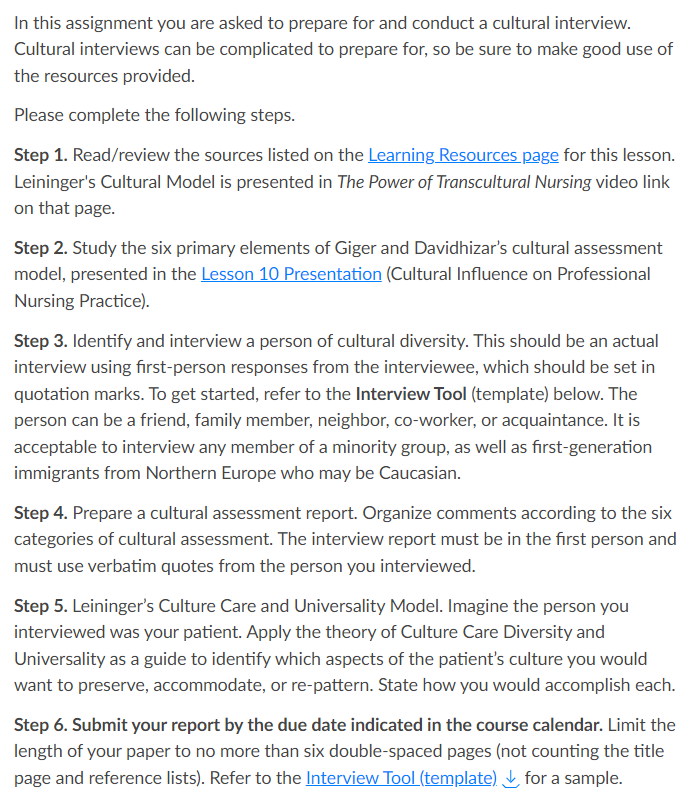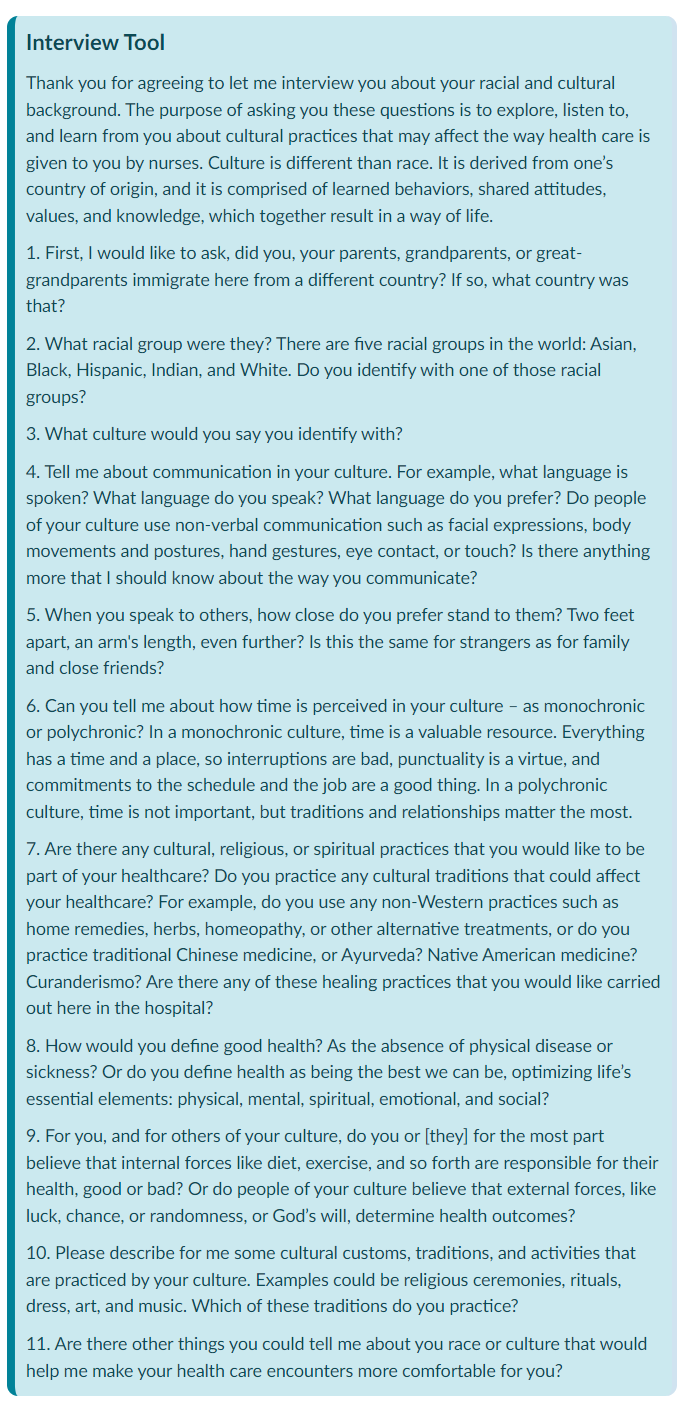Conducting a Cultural Needs Assessment in Healthcare
Overview
Students in the nursing program apply their theoretical knowledge to conducting an interview and setting up a care plan that is culturally congruent with their interviewee.
Why Use This?
This activity requires students to think about equity, diversity, and inclusion from the patient’s perspective and work to develop a culturally congruent approach to providing care.
How Does It Work?
This activity is broken into two parts. In Part 1, students review two essential resources—both are models of cultural assessment that can be applied in healthcare—and an interview template created by the instructor. In Part 2, a discussion, students use the interview template to develop a “culturally congruent” care plan.

In this assignment you are asked to prepare for and conduct a cultural interview. Cultural interviews can be complicated to prepare for, so be sure to make good use of the resources provided.
Please complete the following steps.
Step 1. Read/review the sources listed on the Learning Resources page for this lesson. Leininger’s Cultural Model is presented in The Power of Transcultural Nursing video link on that page.
Step 2. Study the six primary elements of Giger and Davidhizar’s cultural assessment model, presented in the Lesson 10 Presentation (Cultural Influence on Professional Nursing Practice).
Step 3. Identify and interview a person of cultural diversity. This should be an actual interview using first-person responses from the interviewee, which should be set in quotation marks. To get started, refer to the Interview Tool (template) below. The person can be a friend, family member, neighbor, co-worker, or acquaintance. It is acceptable to interview any member of a minority group, as well as first-generation immigrants from Northern Europe who may be Caucasian.
Step 4. Prepare a cultural assessment report. Organize comments according to the six categories of cultural assessment. The interview report must be in the first person and must use verbatim quotes from the person you interviewed.
Step 5. Leininger’s Culture Care and Universality Model. Imagine the person you interviewed was your patient. Apply the theory of Culture Care Diversity and Universality as a guide to identify which aspects of the patient’s culture you would want to preserve, accommodate, or re-pattern. State how you would accomplish each.
Step 6. Submit your report by the due date indicated in the course calendar. Limit the length of your paper to no more than six double-spaced pages (not counting the title page and reference lists). Refer to the Cultural Interview Template Download Interview Tool (template) for a sample.

Interview Tool
Thank you for agreeing to let me interview you about your racial and cultural background. The purpose of asking you these questions is to explore, listen to, and learn from you about cultural practices that may affect the way health care is given to you by nurses. Culture is different than race. It is derived from one’s country of origin, and it is comprised of learned behaviors, shared attitudes, values, and knowledge, which together result in a way of life.
- First, I would like to ask, did you, your parents, grandparents, or great-grandparents immigrate here from a different country? If so, what country was that?
- What racial group were they? There are five racial groups in the world: Asian, Black, Hispanic, Indian, and White. Do you identify with one of those racial groups?
- What culture would you say you identify with?
- Tell me about communication in your culture. For example, what language is spoken? What language do you speak? What language do you prefer? Do people of your culture use non-verbal communication such as facial expressions, body movements and postures, hand gestures, eye contact, or touch? Is there anything more that I should know about the way you communicate?
- When you speak to others, how close do you prefer stand to them? Two feet apart, an arm’s length, even further? Is this the same for strangers as for family and close friends?
- Can you tell me about how time is perceived in your culture – as monochronic or polychronic? In a monochronic culture, time is a valuable resource. Everything has a time and a place, so interruptions are bad, punctuality is a virtue, and commitments to the schedule and the job are a good thing. In a polychronic culture, time is not important, but traditions and relationships matter the most.
- Are there any cultural, religious, or spiritual practices that you would like to be part of your healthcare? Do you practice any cultural traditions that could affect your healthcare? For example, do you use any non-Western practices such as home remedies, herbs, homeopathy, or other alternative treatments, or do you practice traditional Chinese medicine, or Ayurveda? Native American medicine? Curanderismo? Are there any of these healing practices that you would like carried out here in the hospital?
- How would you define good health? As the absence of physical disease or sickness? Or do you define health as being the best we can be, optimizing life’s essential elements: physical, mental, spiritual, emotional, and social?
- For you, and for others of your culture, do you or [they] for the most part believe that internal forces like diet, exercise, and so forth are responsible for their health, good or bad? Or do people of your culture believe that external forces, like luck, chance, or randomness, or God’s will, determine health outcomes?
- Please describe for me some cultural customs, traditions, and activities that are practiced by your culture. Examples could be religious ceremonies, rituals, dress, art, and music. Which of these traditions do you practice?
Are there other things you could tell me about you race or culture that would help me make your health care encounters more comfortable for you?
Keep In Mind
For nursing or other healthcare faculty, it is important to be well-versed in the two cultural assessment models used in this example. For faculty in other disciplines, the models can be a helpful guide to integrating cultural awareness into similar assignments or activities.